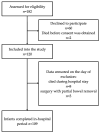Nutrient Intake with Early Progressive Enteral Feeding and Growth of Very Low-Birth-Weight Newborns
- PMID: 35334838
- PMCID: PMC8955398
- DOI: 10.3390/nu14061181
Nutrient Intake with Early Progressive Enteral Feeding and Growth of Very Low-Birth-Weight Newborns
Abstract
Early nutrition is one of the most modifiable factors influencing postnatal growth. Optimal nutrient intakes for very preterm infants remain unknown, and poor postnatal growth is common in this population. The aim of this study was to assess nutrient intake during the first 4 weeks of life with early progressive enteral feeding and its impact on the in-hospital growth of very low-birth-weight (VLBW) infants. In total, 120 infants with birth weights below 1500 g and gestational ages below 35 weeks were included in the study. Nutrient intakes were assessed daily for the first 28 days. Growth was measured weekly until discharge. Median time of parenteral nutrition support was 6 days. Target enteral nutrient and energy intake were reached at day 10 of life, and remained stable until day 28, with slowly declining protein intake. Median z-scores at discharge were -0.73, -0.49, and -0.31 for weight, length, and head circumference, respectively. Extrauterine growth restriction was observed in 30.3% of the whole cohort. Protein, carbohydrates, and energy intakes correlated positively with weight gain and head circumference growth. Early progressive enteral feeding with human milk is well tolerated in VLBW infants. Target enteral nutrient intake may be reached early and improve in-hospital growth.
Keywords: enteral feeding; extrauterine growth restriction; growth; newborn; nutritional intake; very low birth weight.
Conflict of interest statement
The authors declare no conflict of interest. The funders had no role in the design of the study; in the collection, analyses, or interpretation of data; in the writing of the manuscript; or in the decision to publish the results.
Figures







Similar articles
-
Early full enteral feeding for preterm or low birth weight infants.Cochrane Database Syst Rev. 2020 Dec 27;12(12):CD013542. doi: 10.1002/14651858.CD013542.pub2. Cochrane Database Syst Rev. 2020. PMID: 33368149 Free PMC article.
-
[Multicenter study of the nutritional status of premature infants in neonatal intensive care unit in China: report of 974 cases].Zhonghua Er Ke Za Zhi. 2009 Jan;47(1):12-7. Zhonghua Er Ke Za Zhi. 2009. PMID: 19573373 Chinese.
-
Length of Nutritional Transition Associates Negatively with Postnatal Growth in Very Low Birthweight Infants.Nutrients. 2021 Nov 6;13(11):3961. doi: 10.3390/nu13113961. Nutrients. 2021. PMID: 34836216 Free PMC article.
-
Growth, efficacy, and safety of feeding an iron-fortified human milk fortifier.Pediatrics. 2004 Dec;114(6):e699-706. doi: 10.1542/peds.2004-0911. Epub 2004 Nov 15. Pediatrics. 2004. PMID: 15545616 Clinical Trial.
-
High versus standard volume enteral feeds to promote growth in preterm or low birth weight infants.Cochrane Database Syst Rev. 2021 Mar 9;3(3):CD012413. doi: 10.1002/14651858.CD012413.pub3. Cochrane Database Syst Rev. 2021. PMID: 33733486 Free PMC article.
Cited by
-
Relationship between nutrient intakes in the transition phase and postnatal growth of preterm infants: a systematic review.Ital J Pediatr. 2023 Jan 21;49(1):13. doi: 10.1186/s13052-022-01406-3. Ital J Pediatr. 2023. PMID: 36670430 Free PMC article.
-
Neurally adjusted ventilatory assist (NAVA) and postnatal growth.Eur J Pediatr. 2022 Sep;181(9):3557. doi: 10.1007/s00431-022-04541-5. Epub 2022 Jun 29. Eur J Pediatr. 2022. PMID: 35767194 No abstract available.
-
Comment on Brinkis et al. Nutrient Intake with Early Progressive Enteral Feeding and Growth of Very Low-Birth-Weight Newborns. Nutrients 2022, 14, 1181.Nutrients. 2022 Jun 27;14(13):2651. doi: 10.3390/nu14132651. Nutrients. 2022. PMID: 35807832 Free PMC article.
-
Reply to Manzar, S. Comment on "Brinkis et al. Nutrient Intake with Early Progressive Enteral Feeding and Growth of Very Low-Birth-Weight Newborns. Nutrients 2022, 14, 1181".Nutrients. 2022 Jun 27;14(13):2653. doi: 10.3390/nu14132653. Nutrients. 2022. PMID: 35807834 Free PMC article.
-
A Retrospective Study Evaluating Guideline Adherence of Neonatal Parenteral Nutrition in a Belgian Neonatal Intensive Care Unit.Cureus. 2024 Mar 21;16(3):e56654. doi: 10.7759/cureus.56654. eCollection 2024 Mar. Cureus. 2024. PMID: 38646227 Free PMC article.
References
-
- Niklasson A. Handbook of Growth and Growth Monitoring in Health and Disease. Springer; New York, NY, USA: 2012. Growth from 24 Weeks to 24 Months in Preterm Infants: Experience from a Swedish Population; pp. 2923–3295.
MeSH terms
LinkOut - more resources
Full Text Sources
Medical

